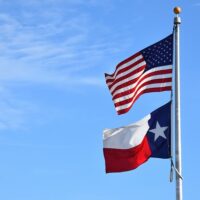Fly Your Flag

With Memorial Day, Flag Day, and Independence Day all in close proximity on the calendar, summer is one of the most patriotic times of the year. That means there are plenty of opportunities to proudly display the flags of our nation and our state. Let’s take a look at what regulations there are around flying US flags and Texas flags:
When and where to display the flag?
Both flags should be displayed daily on or near the main administrative building of every state or public institution (4 U.S.C §6(e) (2018), Tex. Gov’t Code §3100.051(2)). Plus, the US flag should be displayed in or near every school during school days (4 U.S.C §6(g) (2018)).
It is the universal custom to only display the US flag from sunrise to sunset. But the code specifies that flying the flag for 24 hours is permitted when patriotic effect is desired, and if the flag is properly illuminated during darkness. This provision applies to the Texas flag as well (4 U.S.C §6(a) (2018), Tex. Gov’t Code §3100.052(a) & (b)). Additionally, neither flag should be flown in inclement weather, unless it is an all-weather or weatherproof flag (4 U.S.C §6(c) (2018), Tex. Gov’t Code §3100.052(c)).
What if I’m flying multiple different flags at the same time?
Just like math, there is an order of operations. The positions of prominence are the highest point, and the furthest to the flag’s right (the observer’s left). The US flag always gets the most prominence, and no flag should be flown above, or if on the same level, further to the observer’s left than Old Glory (4 U.S.C §6(c) (2018)). In Texas, the Texas flag is next in line. No flag can be displayed above or further to the observer’s left, other than the US flag (Tex. Gov’t Code §3100.054).
In Texas, these flags are often flown together. Luckily, Section 3100.055 of the Texas Government Code spells out the requirements in that situation. It states that if the state flag and the US flag are displayed on the same flagpole, the US flag should be above the state flag. But if the state flag and the US flag are displayed on different flagpoles at the same location, the flags should be:
- at the same height,
- of approximately equal size,
- and the flag of the United States should be to the left of the state flag, from the perspective of the observer
Additionally, both flags should be hoisted briskly, and lowered ceremoniously (4 U.S.C §6(b) (2018), Tex. Gov’t Code §3100.068(a)). But the US flag should always be hoisted first, and lowered last.
Is there anything else I should know?
Neither flag should ever be flown upside down (the blue down on the US, the white stripe down on the Texas), unless as a signal of dire distress in instances of extreme danger (4 U.S.C §8(a) (2018), Tex. Gov’t Code §3100.053).
Neither flag should ever touch anything beneath it, like the ground, the floor, or water (4 U.S.C §8(b) (2018), Tex. Gov’t Code §3100.070(a.1)).
Both flags should be destroyed in a dignified manner, preferably by burning, when they are no longer a fitting emblem of display (4 U.S.C §8(k) (2018), Tex. Gov’t Code §3100.151).
It is important to keep all these guidelines in mind when flying your US and/or Texas flags. Keep up to date on the news, as these requirements can be changed by the President of the United States or the Governor of Texas (4 U.S.C §10 (2018), Tex. Gov’t Code §3100.071).
Please do not rely on this article as legal advice. We can tell you what the law is, but until we know the facts of your given situation, we cannot provide legal guidance. This website is for informational purposes and not for the purposes of providing legal advice.
